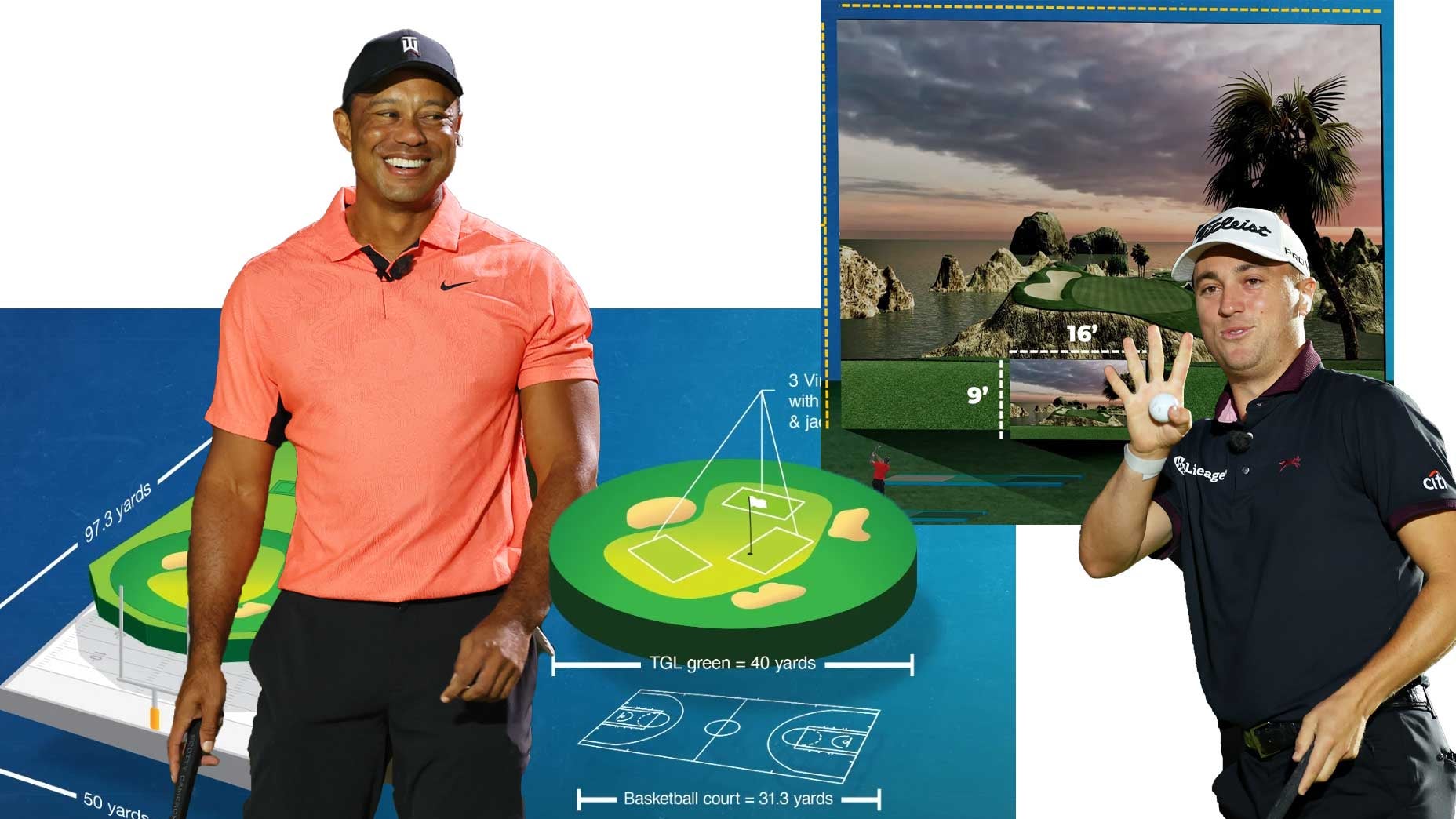The PGA Tour year may be winding to a close, but one thing is just getting started: The TGL. The mixed-reality golf league from TMRW Sports, launched by Tiger Woods and Rory McIlroy, is barreling down the path to its inaugural season, and we learned a lot more about what it’ll look like Tuesday.
Haven’t you heard? Justin Thomas is now a member of the Atlanta Drive. Not sure what that means? You’re not alone. But Thomas is one of 24 players taking part, who will all be members of the six founding TGL teams, competing in a round-robin slate of matches on Monday and Tuesday nights this spring. You’ll be able to watch it all on ESPN, starting Jan. 9, but what exactly will you be watching? We outline it below.
TGL Competition Format Explained:
Triples and Singles — no Doubles
For each match, each TGL team will send three players to SoFi Center in Palm Beach, Fla., a made-for-purpose arena that will fit 1,600 spectators. They’ll begin by playing what TGL is calling “Triples,” a three-man alternate shot competition for the first nine holes of the night.
After the Triples, the match will pivot to one-on-one. That’s what TGL is calling “Singles.” (Zero points for creativity on the session names.) Individual players from each team will face off against one opponent from the other team on individual holes.
EXAMPLE: Justin Thomas plays Tiger Woods on the 10th hole. Max Homa plays Rickie Fowler on the 11th hole. Collin Morikawa plays Patrick Cantlay on the 12th hole. Then JT and Tiger kick off the final three holes by playing against each other again.
For those doing their own math, that’s nine holes of Triples and six holes of Singles, adding up to 15 holes on the night. Not 18. The pace of play should be quick, as the TV window for these matches is just two hours long. This is largely virtual golf as players make their way to the green, so there won’t be time spent walking to wherever their balls end up.
Most points wins
Teams will be competing for points, which are earned in a simple way: by winning holes. If our imaginary team of Woods, Fowler and Cantlay made an alternate-shot birdie on 1 to beat their opponent, and then tie the 2nd hole, they’re up one point. Importantly, up one point does not mean the same as 1 Up. At least, not in the sense we are used to with golf matches.
Every one of the 15 holes will be played during every match, meaning there are 15 points up for grabs. If a team is four points up with three holes to play, they will not call the match. Rather, they’ll play out those final three holes to see how lopsided the match was. And they need to. The year-end tiebreaker is Total Number of Holes Won. So, TGL scores will look more like baseball scores, if anything. Expect to see a lot of 4-3 ballgames.
Also, expect a number of the teams and matches to be released soon. We are just two months away from launch week.
True mixed-reality
You may have heard about the 64-by-46 foot mega simulator screen that players will be hitting into. That’s virtual. But they’ll be hitting from real-life surfaces. Real, shortly mown grass to emulate fairways and tees, as well as real, rough-like, thicker grasses to represent what it’s like when players miss the fairway. There will be real sand from which players will play bunker shots.

Once players have virtually advanced within about 50 yards of the hole, the short-game area will come to life. Their real golf balls will be placed in the respective spots in the competition area, and 189 actuators and jacks beneath the surface will make every time it is used feel different. Ultimately, the short game area is bigger than four basketball courts and encompasses three putting greens, the slopes of which can be dictated to any degree.
Overtime!
One of the tastiest aspects of this competition is that we will eventually see overtime. It may not come during the first night, or even the first few, but eventually there will be a 4-4 tie after 15 holes. From there, players will take individual shots into the screen, alternating between the teams like a penalty shootout. The goal: be the first team to win TWO closest-to-the-pin challenges against the other team.
EXAMPLE: Tiger Woods snipes the green, while Justin Thomas misses the green. That’s ONE for Woods’ team. Then both Max Homa and Rickie Fowler miss the green. Zero points for that. Collin Morikawa’s does what he does best and hits it close against Patrick Cantlay. All tied up. Then Tiger Woods does what Tiger Woods does better than anyone in history and hits it to a foot, claiming that second closest-to challenge from the bunch. Team TW wins.
Hockey standings
Okay, but what do they win? The TGL is clearly keen to incorporate concepts that work in other sports. But winning any given TGL match will be worth two points on the year-long standings race, whether it happens in regulation or in overtime, like we referenced above. A loss will be worth nothing, unless it happens in overtime, like we referenced above. Overtime losses, like in hockey, are still worth one point on the year-long race. It may not comfort Justin Thomas in the moment, but it may be the difference between advancing and having your TGL season finish before the playoffs.
Of the six teams competing, four will advance to the semi-finals matches. From there, the two winning teams will play a best-of-three championship series for the inaugural TGL championship.










